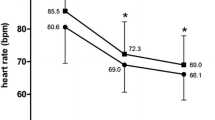Abstract
ULFS 49 CL, a so-called sinus node inhibitor, does not affect β-adrenergic or muscarinic receptors at therapeutical plasma concentrations in man. The compound’s underlying mechanism of action to decrease heart rate can be explained by an inhibition of the if-current, which seems to be responsible for the spontaneous depolarization of the pacemaker cells in the sino-atrial node [1, 2]. Like β-blockers, the substance is expected to produce a reduction in heart rate. Through this mechanism ULFS 49 CL may result in antianginal and/or antiischemic efficacy in patients with angina pectoris. At present, no data are available on its antiischemic potential. The aim of the present multicenter trial was to investigate the antianginal, antiischemic, and hemodynamic effects of ULFS 49 CL, a new heart-rate-reducing compound, in patients with stable angina pectoris.
Access this chapter
Tax calculation will be finalised at checkout
Purchases are for personal use only
Preview
Unable to display preview. Download preview PDF.
Similar content being viewed by others
References
Lillie C, Kobinger W (1986) Investigations into the bradycardic effects of ULFS 49 CL (l,3,4,5-tetrahydro-7,8-dimethoxy-3-3-(3-k((2-(3,4-dimethoxyphenyl))ethyl) methyliminopropyl)-2H-3-benzazepin-2-on-hydrochloride) in isolated guinea pig atria. J Cardiovasc Pharmacol 8: 791–797.
Krumpl G, Schneider W, Raberger G (1986) Can exercise-induced regional contractile dysfunction be prevented by selective bradycardic agents? Naunyn-Schmiedebergs Arch Pharmacol 334: 540–543.
Le CG (1987) On testing a trend in means in oneway layout. Biometrical Journal 29 /2: 173–180.
Morrison DF (Multivariate statistical methods. International Student Edition. McGraw-Hill International Book Company. Auckland Bogota Guatema Hamburg Johannesburg Lisbon London Madrid Mexico New Delhi Panama Paris San Juan Sao Paulo Singapore Sydney Tokyo. 2. Edition, 4th print 1982.
Author information
Authors and Affiliations
Editor information
Editors and Affiliations
Rights and permissions
Copyright information
© 1991 Dr. Dietrich Steinkopff Verlag GmbH & Co. KG, Darmstadt
About this paper
Cite this paper
Pitschner, H.F. et al. (1991). Antiischemic, antianginal, and hemodynamic effects of ULFS 49 CL (a new heart-rate-reducing agent) in patients with angiographically proven CAD. In: Hjalmarson, Å., Remme, W.J. (eds) Sinus node inhibitors. Steinkopff. https://doi.org/10.1007/978-3-642-72458-9_5
Download citation
DOI: https://doi.org/10.1007/978-3-642-72458-9_5
Publisher Name: Steinkopff
Print ISBN: 978-3-7985-0861-3
Online ISBN: 978-3-642-72458-9
eBook Packages: Springer Book Archive




